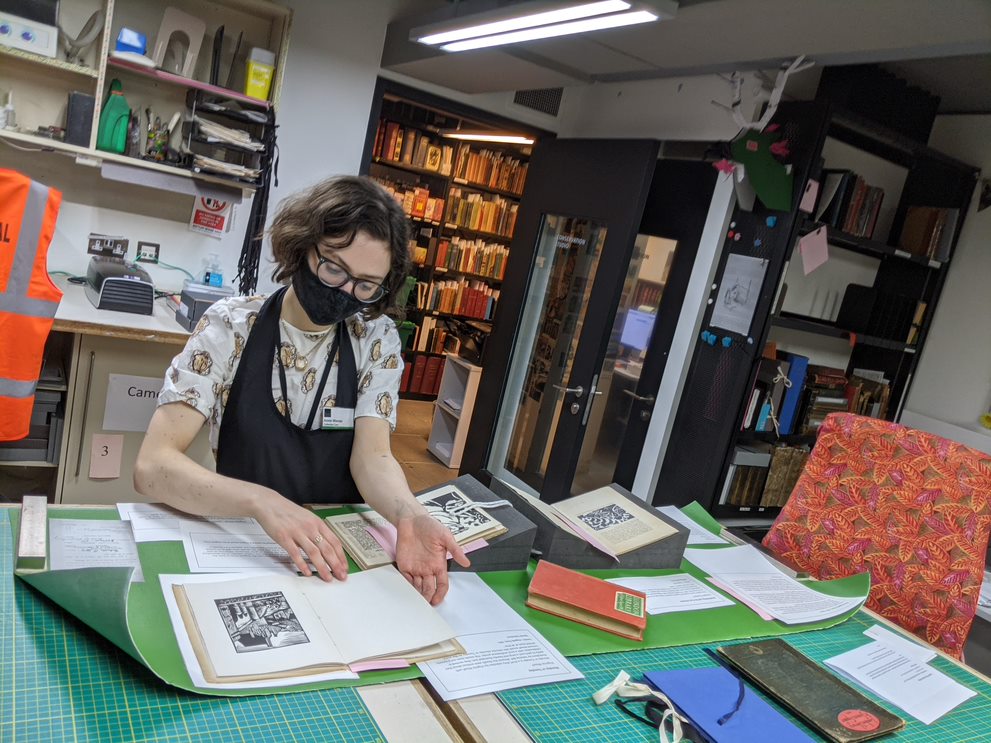
LEFT: Annie Werner (left) arranges a book under the supervision of Conservator Meagen Smith (right). RIGHT: The display in the Reading Room.
The Hogarth Press was a publishing house founded in 1917 by Leonard and Virginia Woolf and was named after their house in Richmond, in which they began hand-printing books. The London Library is fortunate to hold several examples of the Hogarth Press’s rare early work and visitors to The Reading Room will see that a temporary new display has been installed. All of Hogarth items are in our Special Collections and available to view by appointment but we are delighted to be able to share some of our favourites with members that come to work in the Library. Our open stacks also contain extensive holdings of Virginia Woolf’s writing, some of which feature original covers designed by Vanessa Bell, as well as the complete set of Leonard Woolf’s autobiographies as donated by the publisher.

Stack Assistant Annie Werner lays out the display in the London Library’s Conservation Studio.
Virginia Woolf grew up in a London Library household. The novelist was born Adeline Virginia Stephen in 1882 to Julia and Sir Leslie Stephen, both prominent members of the Victorian arts and literary scene. In 1892, Virginia and her elder sister Vanessa (later the artist Vanessa Bell) cheerfully noted the results of a recent election at The London Library in their homemade newsletter:
Mr Leslie Stephen whose immense litterary [sic] powers are well known is now the President of The London Library which as Lord Tennyson was before him and Carlysle [sic] was before Tennyson is justly esteemed a great honour. […] We think that The London Library has made a very good choice.
The Stephen sisters’ newsletter, The Hyde Park Gate News, displays Virginia’s early interest in the materiality of texts. Although The Hyde Park Gate News was handwritten in Vanessa’s cursive, it was styled in columns to resemble a traditional broadsheet and bound in brown cloth. Virginia would later study bookbinding – a popular pastime for Victorian ladies – and spend several months rhapsodising about her new hobby in her diary and letters.
Virginia and Vanessa Stephen joined the Library formally in 1904, shortly after the death of their father. Virginia, then twenty two, listed her occupation as ‘Spinster’ on her joining form. Later that same year she met Leonard Woolf. A fellow London Library member, Leonard Woolf was a former civil servant who had resigned his post in Ceylon in disgust over the brutality of empire. The pair married in 1912.
Virginia Woolf’s first novel, The Voyage Out, was published by Gerald Duckworth and Company in 1915. This contract with Duckworth caused her intense distress. Woolf had always been sensitive to criticism of her work and despised Gerald Duckworth, who was her half-brother on her mother’s side.
Recognising that Virginia was on the verge of a mental health crisis, the Woolfs looked for a constructive outlet for her nervous energy. On her thirty-third birthday, Virginia wrote in her diary that they had decided both ‘to take Hogarth [House], if we can get it’ and to buy a printing press. She continued, ‘I am very much excited at the idea […] — particularly the press.’
The move to Hogarth House was completed in 1915, but Virginia’s fragile mental health prevented them from establishing the Hogarth Press on the site until 1917. The Woolfs purchased a small hand-press from a hobbyist shop in Farringdon and advertised their intent to ‘publish at low prices short works of merit, in prose or poetry, which could not, because of their merits, appeal to a very large public.’ Their first publication was Two Stories, featuring one story by each Woolf.
The Hogarth Press would later become conventional publishing house, but in the hand-press years of 1917-1925 it was decidedly an amateur operation: Leonard handled the printing and administration while Virginia did the typesetting and binding. These hand-press books are all short texts – either short stories or poetry – because setting each page could take upwards of an hour. They are also bound expediently, in stiff paper wrappers rather than board. The early Hogarth Press books are special objects not because they were skilfully or beautifully made, but because of their connection with the hands and mind of one of the twentieth century’s greatest novelists.
We hope many of you will have the opportunity to go and see the items on display in the Reading Room.

